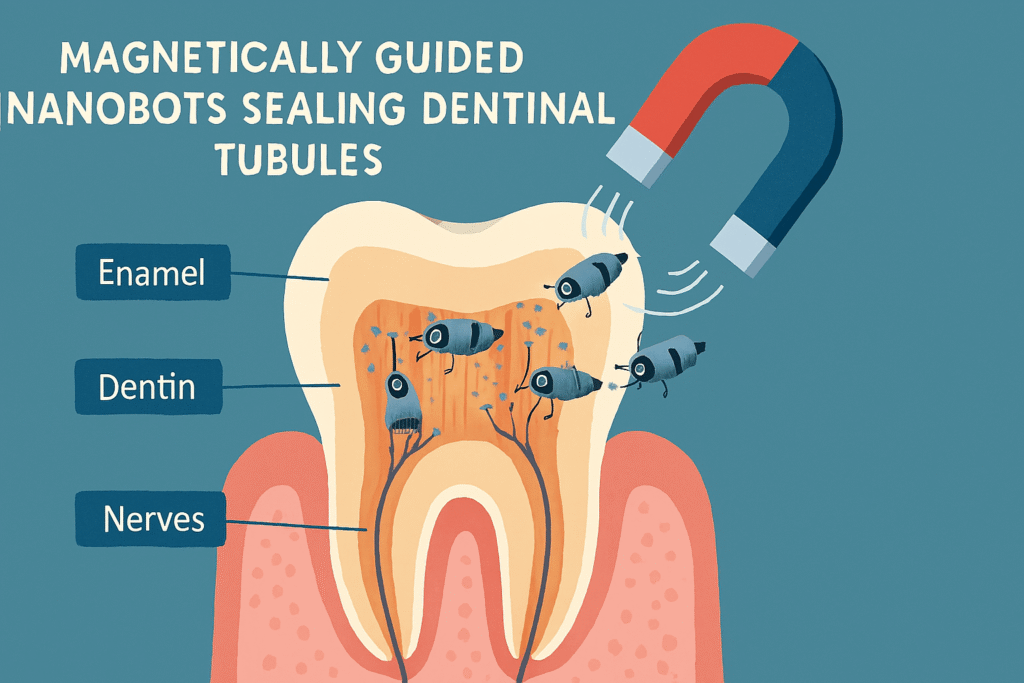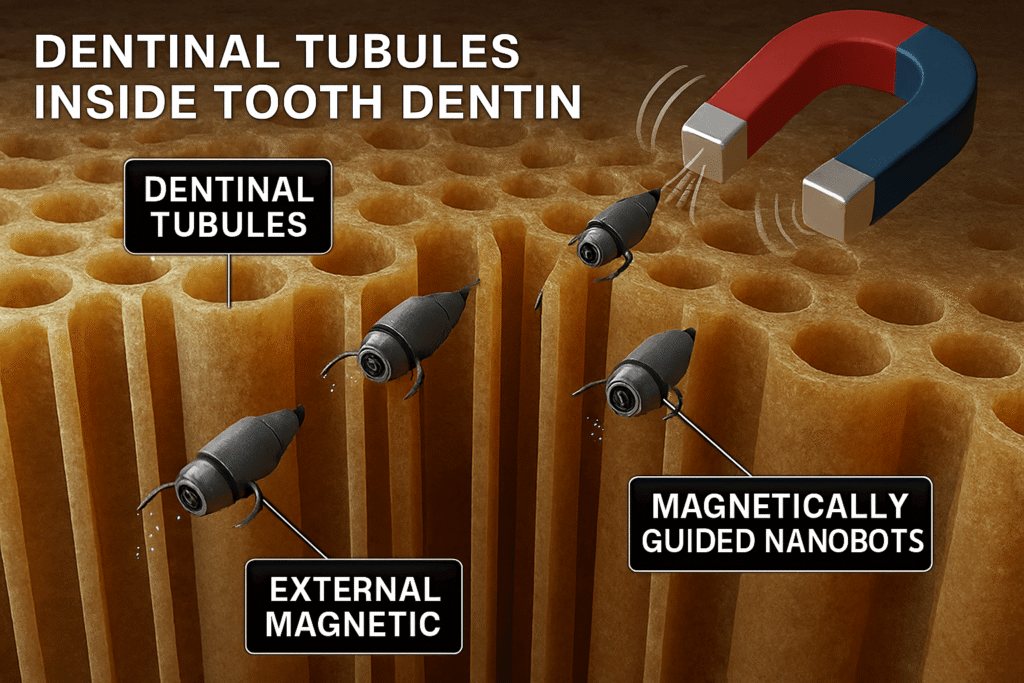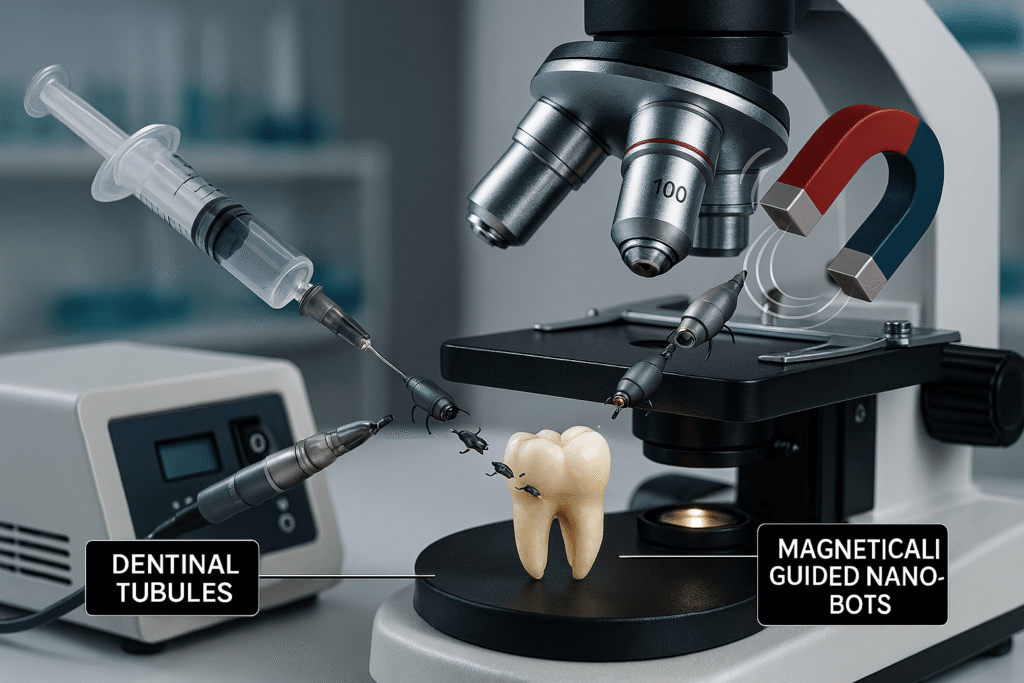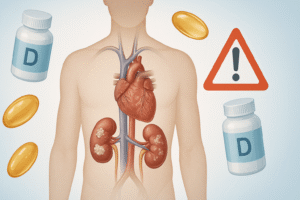
Magnetically guided nanobots sealing dentinal tubules for tooth sensitivity relief
IISc’s magnetically guided nanobots seal dentinal tubules and may give lasting tooth sensitivity relief in a single application.
Tooth sensitivity is a common problem. It can make hot, cold, sweet, or acidic foods painful. Now, researchers at the Indian Institute of Science (IISc) and partners have a promising fix. They developed tiny, magnetically guided nanobots that can seal dentinal tubules. Early results suggest a single treatment could provide long-lasting relief. This article explains the science. It also covers what was tested, why it matters, and what comes next.
What are dentinal tubules, and why do they cause sensitivity?
Dentin sits under the enamel. It has microscopic channels called dentinal tubules. These tiny tubes lead directly toward nerve endings. When enamel wears away, those tubules become exposed. Fluids then move inside the tubules. That movement triggers nerves. The result is sharp pain or sensitivity. Standard treatments include desensitizing toothpastes, fluoride varnishes, and dental procedures. But many options need repeated applications and give only temporary relief.
How magnetically guided nanobots work

The new approach uses magnetically guided nanobots filled with a calcium-based formulation. The bots are about a few hundred nanometers across. Under an externally applied magnetic field, they can be steered. So, they travel deep into the dentinal tubules. Once inside, the bots deposit material. That material forms stable plugs that block the tubules. In effect, the plugs prevent fluid movement. This reduces or removes the pain signal.
A plain-language way to picture this: imagine sealing tiny tunnels in a wall so no drafts pass through. The drafts are like fluid movement, and the seal is the nanobots’ deposit. The difference is scale — we’re talking microscopic tunnels and nano-scale robots. Medical Xpress, NewsBytes
Who built them, and where was the work done?
The core research was led by teams at the Indian Institute of Science (IISc), Bengaluru. The work involved collaboration with an IISc-incubated deep-tech startup. IISc scientists published lab results and the institute highlighted the work in its news and events pages. Independent science outlets and mainstream media reported on the findings and on lab tests using extracted human teeth and animal models. iisc.ac.in, Medical Device Network, Medical Xpress
Read the IISc piece here: Tiny bots that can deep clean teeth (IISc).
See broad media coverage here: MedicalXpress coverage of the nanobots.
(Links are in the references section at the end.)
What the experiments actually showed

Researchers tested the nanobots on extracted human teeth and in animal trials. On human teeth, they exposed dentin and then applied the nanobot formulation. They used magnetic fields for roughly 20 minutes to guide the bots into the tubules. High-resolution imaging showed deep, stable plugs in the tubules after treatment. The seals resisted mechanical stress and did not wash out easily. In animal tests, treated animals showed behavior consistent with reduced tooth sensitivity. Mirage News, NewsBytes
These are lab and preclinical results. They are promising. But they are not yet the same as clinical trials in humans carried out under regulatory oversight.
Why magnetically guided nanobots could be better than current treatments
First, current desensitizing toothpastes and varnishes rely on passive diffusion. They often fail to reach the deepest parts of dentinal tubules. As a result, relief may be partial and short-lived. In contrast, magnetically guided nanobots actively navigate into narrow, tortuous channels. They can reach places that liquid or brush-based products can’t. That means deeper, more stable sealing of tubules.
Second, the seal formed by the nanobots appears durable. Early imaging suggests the plugs remain in place under stress. If this holds in humans over months or years, patients might get lasting relief after one treatment. That could reduce repeat visits and ongoing use of desensitizing products. Medical Xpress, PMC
The science behind magnetic steering
These nanobots contain magnetic material. When exposed to an external field, they align and move in the desired direction. Researchers can tweak the frequency and strength of the magnetic field. That tuning changes how the bots move. In previous IISc work, similar magnetic guidance was used to disinfect tubules during root-canal contexts. The same steering principles apply here. Also, careful control prevents unwanted clumping (agglomeration) of bots. That makes movement predictable and safe in confined spaces. iisc.ac.in, cense.iisc.ac.in
Safety and biocompatibility
Any medical technique must prove safe. The IISc team designed the nanobots to be biocompatible. The materials used include calcium-based compounds, similar to what dentists already use in certain fillings and sealants. Lab tests checked for unwanted inflammation and toxic effects. Early reports say outcomes were favorable. Still, more extensive toxicity and safety testing are necessary before human clinical trials.
Note: “biocompatible” in a lab does not mean automatically safe for humans. Regulatory approval requires phased clinical trials. The trials must measure short- and long-term effects, immune responses, and any off-target behavior of nanobots. Medical Xpress, Medical Device Network
Potential applications beyond sensitivity
Though this study focused on sealing tubules for sensitivity, the technology has wider potential. Magnetically guided nanobots have been explored as tools to disinfect dentinal tubules during root canal treatment. They can carry heat, antibacterial agents, or other payloads. They might also assist targeted drug delivery inside tiny biological compartments. In short, the technology could reshape certain dental procedures and targeted therapies if it proves safe and effective in humans. PMC. Inc42
Limitations and honest caveats
First, most published work so far is at the lab or animal study stage. That means we don’t have human clinical trial results yet. Second, steering magnetic nanobots requires external equipment. Dental clinics would need the appropriate magnet-control devices and trained staff. Third, cost could be an issue initially. New technologies often carry higher upfront costs until they scale.
Finally, the long-term stability of the seals in the human mouth — which is a harsh environment — needs to be tested over months and years. Dental enamel faces chewing forces, acid attacks, temperature swings, and microbiome activity. All these factors could affect how long a nanobot plug lasts.
What’s next — path to the clinic
The path from lab to clinic is clear but rigorous. It typically includes:
- Extended preclinical safety testing.
- Phase I human trials (safety, small group).
- Phase II trials (efficacy and dosing).
- Phase III trials (larger populations, comparisons).
- Regulatory approvals and commercialization.
The IISc team and their startup partners will likely move to larger preclinical tests and then seek regulatory permissions for human studies. If trials confirm safety and durable efficacy, clinics may adopt the technique in the years to come. The timeline depends on the results at each step. Medical Xpress, Inc42
Practical takeaways for readers
If you have tooth sensitivity today, continue to follow proven dental advice. Use dentist-recommended desensitizing toothpaste. See a dentist for diagnosis. Keep good oral hygiene. The nanobot approach is exciting. Yet, it is not yet a consumer treatment. Instead, think of it as a glimpse of what dental care may offer in the future: targeted, deep interventions that reduce the need for repeated treatments.
Where to read more (key sources)
- IISc — “Tiny bots that can deep clean teeth” (IISc event/news summary).
https://iisc.ac.in/events/tiny-bots-that-can-deep-clean-teeth/ iisc.ac.in - MedicalXpress — “Magnetically guided nanobots offer lasting relief for tooth sensitivity” (news summary).
https://medicalxpress.com/news/2025-08-magnetically-nanobots-relief-tooth-sensitivity.html Medical Xpress - Mirage News — coverage of the IISc nanobots tests on extracted teeth and animal trials.
https://www.miragenews.com/nanobots-relieve-tooth-sensitivity-with-1512847/ Mirage News - NewsBytes — short summary of the research and lab findings.
https://www.newsbytesapp.com/news/science/tiny-magnetic-nanobots-can-cure-your-tooth-sensitivity/tldr NewsBytes - PubMed / PMC — background review on “mobile nanobots” for dental tubule disinfection and related foundational work.
https://pmc.ncbi.nlm.nih.gov/articles/PMC7613116/ PMC
Medical Disclaimer
This article is for informational purposes only and is not a substitute for professional dental advice, diagnosis, or treatment. Always seek the guidance of your dentist or qualified healthcare provider with any questions you may have regarding a dental condition or before starting any new treatment. Never disregard professional advice or delay seeking it because of information you have read here.
Call to Action
Tooth sensitivity shouldn’t stop you from enjoying your favorite foods and drinks. If you experience discomfort, schedule an appointment with your dentist to discuss current treatment options and stay informed about emerging innovations like magnetically guided nanobots. Share this article with friends and family to spread awareness about the exciting future of dental care.





